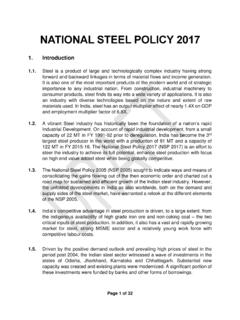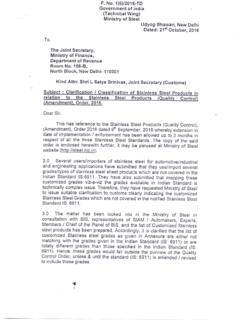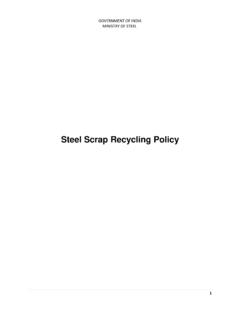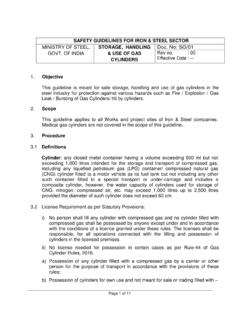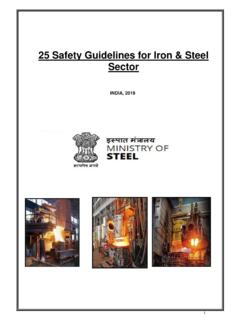Transcription of Safety Guideline for Steel Melting Shop
1 Page 1 of 32 RECOMMENDED GUIDELINES FOR IRON & Steel SECTOR MINISTRY OF Steel , GOVT. OF INDIA Steel Melting SHOP Doc. No: SG/39 Rev no. : 00 Effective Date: 1. OBJECTIVE: Steel Melting Shop (SMS) receives Hot Metal (HM) from Iron- making units and converts it into various grades of Steel and casts them into Slabs, Blooms, Billets, Beam blanks, Rounds and thin slab- HR coils. Those are delivered as products to down-stream units (Long, Section & Flat Products). SMS is the first stage in the Steel manufacturing value chain where product differentiation and customization starts. This entire process of Steel making is associated with various Safety hazards like exposure to excessive heat, dust, noise, fire and explosion, fall from height, confined space, electrical shock, gas & radioactive leakages related hazards etc. The objective of this document is to identify the hazards associated with Steel Melting shop process & to ensure accident free working. 2. SCOPE: These guidelines are applicable to Steel Melting Shop department of an Integrated Steel Plant.
2 3. PROCESS BRIEF: The Steel Melting Shop has following Units & Auxiliary Departments: The hot metal from Iron making is transported by Open ladles/Torpedoes which are poured out into charging ladle into the furnaces. To convert iron into Steel needs oxygen blowing or combination of oxygen / arcing to reduce carbon, silicon , manganese and phosphorous as main impurities. Typical flow chart is illustrated below. HM Pretreatment (HMPT,HMDS, KR) Primary Steel making (BOF-LD Converter/ CONARC) Secondary Steel making (LHF/RH/VD/ VOD/AOD) Continuous Casting (Slab,Bloom, Billet/Rounds) Doc. No: SG/39, Rev no: 00 Page 2 of 32 Hot Metal (HM) Pre-treatment / Hot Metal Desulphurization: During HM refining, impurity like Silicon, Phosphorous &Sulphur is removed by injection of reagents. In pre-treatment station desiliconization & dephosphorization by oxygen blowing along with iron ore/sinter is done into the ladle or torpedo with continuous deslagging.
3 After the pre-treatment process , co-injection / mono-injection or stirring process is adopted for desulphurisation, slag skimming is done in Hot Metal ladles to ensure slag free metal for Primary steelmaking. In some of the old Steel melt shops, hot metal transferred in open top ladles are poured in Mixer units for temperature & composition homogenisation of hot metal received from different blast furnaces. The Mixer unit also acts as a buffer between the blast furnace & BOF units. However present day new Steel melt shops do not have any mixer unit as hot metal is received in torpedo ladle cars. Primary Steel making (BOF Vessel / LD Converter / ConArc): LD Converter : HM & Scrap are charged in one vessel after which O2 is blown to remove impurities in HM. Fluxes are added to get desired quality product output. The basic equipment of CONARC process consists of two identical refractory lined furnace shells, one slewable electrode structure with one set of electrodes serving both the furnace shells, one electric supply (transformer etc.)
4 For both the shells, and one slewable water cooled top oxygen lance system serving both the shells. Alternatively two stationary top lances, one for each furnace shell for the blowing of oxygen can also be used. The basic concept of CONARC process is to carry out decarburization in one shell and electric Melting in another vessel. Doc. No: SG/39, Rev no: 00 Page 3 of 32 Secondary Steel making (LHF / RH degasser / VD / VOD / AOD): LHF : Ladle Heating Furnace ( LHF) ensures reheating of Liquid Steel , coming from BOF Ladle Furnace utilizes electric energy& graphite electrode to raise & maintain Temperature. Homogenization of liquid Steel temperature and chemistry of Steel through inert gas stirring. Steel is refined & final composition is achieved. RH-OB : RH-OB degasser is a secondary refining system that removes dissolved gases such as hydrogen, Nitrogen, reduction of Carbon present in molten Steel to enable the production of high-grade Steel .
5 RH is used to make Ultra low carbon speciality Steel products like IF Steel and Electrical steels. VD : Vacuum de-gassing (VD) is a secondary refining system that removes dissolved gases such as hydrogen, nitrogen present in molten Steel by means of vacuum & argon purging in a tank. Minor composition adjustment is done with alloying as per the special Steel chemistry requirement. VAD : Vacuum Arc Degassing (VAD) unit is a secondary refining system comprising of a tank degasser with electrodes added for the purpose of reheating the liquid Steel with provision of alloy trimming. It has an added advantage of superior desulphurisation potential & nitrogen control required for quality Steel grades with ultra low sulphur levels. AOD: Argon Oxygen Decarburization (AOD) is used during refining for stainless Steel grades and other high grade alloys with oxidisable elements such as chromium and aluminium. Oxygen is blown from top lance & oxygen with argon is blown from the side tuyeres for preferential oxidation of carbon over chromium thereby leading to processing of high chromium stainless steels with lower carbon contents.
6 However AOD is primarily used in conjunction with IF / EAF based route. Caster: Continuous Casting Machine: Caster converts liquid Steel into solid shapes either slabs, bloom, billets, rounds and section of required dimensions as per downstream mill configuration. The liquid Steel is poured in refractory lined tundish from the teeming ladle placed on the ladle turret arm. Thereafter the liquid Steel is poured (controlled pouring through stopper rod arrangement / slide gate arrangement/ open stream through metered nozzles) into the water cooled copper mould and solidified & cast into relevant shapes in the continuous casting strand. The solidified strand is cut into requisite lengths in a torch cutting machine and the cut slabs/ billets/blooms are dispatched to the rolling mill for further processing into saleable Steel . Doc. No: SG/39, Rev no: 00 Page 4 of 32 Auxiliary units: Ladle preparation of all Steel &HM ladles minor, major repairs, Preheating& preparation activities done to smooth batch process of Steel making Slag yard: All BOF & Secondary Steel slag handling in liquid condition Scrap yard: Receiving & Preparing of various scrap kinds to feed BOF continuously.
7 Slab Yard: Slab Handling and transferring of slabs to downstream unit (Hot Strip Mill) Fuel gases/Mixed gasses are used as source heating for heating purposes within the plant for meeting various refractory vessels. Gas Recovery and Export system / Gas Holder: BOF process gas is recovered during O2 blowing and collected in a gas holder and same is exported to gas network of the plant where in gases are fed to power plant and other utility consumers. EOT Cranes are used to handle hot metal / Steel ladles / equipment handling for casters and slab / bloom / billet handling Water Treatment Plant : BOF and Casting process consumes lot of water for cooling equipment / slabs where in primary cooling is closed loop for which water treatment to required quality is maintained. Since these water are hot during process needs to be cooled down through cooling tower on continuous basis. Overhead emergency tanks are also maintained for power failure sustenance.
8 Tundish preparation: Tundish preparation & maintenance equipments comprises of lining stands, tundish cooler, tundish driers, tundish deskulling stands & tundish preheating stations (on casting platform). Depending on the type of casting requirement SEN & SES pre-heating stations are envisaged on casting platform. Some of critical Equipment s/ facilities in Steel Melting Shop Department are as follows: Area Major equipment s Steel making / Melting Shop BOF vessels, Refractory Ladles, RH vessels, Transfer cars Fork Lift, Gradall, Debricker, EOT Cranes, Mobile Cranes, Pay loaders, Bunkers, Gas holder, Gas cooling and cleaning system, ID fans, Transformers Continuous Casting / Caster Turret , Mould , Tundish Car , Segments, Run out table , Torch cutting machine, Deburring machine, Marking machine and product evacuation tables. Auxiliary equipment are water pumps for cooling system and scale flushing system Doc.
9 No: SG/39, Rev no: 00 Page 5 of 32 4. PROCESS HAZARD ANALYSIS & NECESSARY RISK CONTROL MEASURES: Sl. No. Area/Section/Activity Hazards Risk Control Measures Transferring HM from Torpedo to HM Ladles Movement of the HM ladle car and align the ladle properly underneath the Torpedo spout. Hot Metal Spillage Fire 1 Level sensors for free board measurement system to be in place (Laser/Radar/Camera based) to avoid overfilling 2 Fire hydrant and Extinguishers to be kept as standby, 3 Bunds are made to avoid metal flowing to vast areas (Refer SG-16, Safety guidelines for Fire Safety , SG-23: Safe handling of liquid metal) Make the Electric plug connection Electric shock 1 Electric shock proof hand gloves to be used. 2 Regular maintenance of plug to be ensured. (Refer SG-18: Personal Protective Equipment PPE Management) Pouring of Hot Metal from Torpedo ladles to hot metal Ladles 1 Metal spillage due to over flow 2 Fire 1 Proper Positioning of the torpedo and controlled tilting to be done prevent the spillage.
10 Visibility to operator should be ensured 2 Functioning of Tilt in / out of torpedo to be checked once before pouring hot metal into ladle (Ref SG-23 for safe handling of liquid metal) 1 Trickling/Puncture of ladle on transfer ladle car(TLC) 2 Fire hazard 3 Explosion 1 Visual inspection of ladle refractory & Life monitoring / Thermography of refractories 2 Hydraulic tanks if any on transfer car to be protected suitably with proper design and use fire resistant oil. 3 Water accumulation in Doc. No: SG/39, Rev no: 00 Page 6 of 32 Sl. No. Area/Section/Activity Hazards Risk Control Measures pouring pits to be drained out/dried with slag (Refer SG-10 for Hydraulic Safety ) Transferring HM from Mixer to HM Ladles Movement of the HM ladle car and align the ladle properly underneath the Mixer spout. Hot Metal Spillage Fire 1 Level sensors for free board measurement system to be in place (Laser/Radar/Camera based) to avoid overfilling 2 Fire hydrant and Extinguishers to be kept as standby, 3 Bunds are made to avoid metal flowing to vast areas (Refer SG-16: Safety guidelines for Fire Safety , SG-23: Safe handling of liquid metal) Pouring of Hot Metal from Mixer to hot metal Ladles spillage due to over flow 2.


